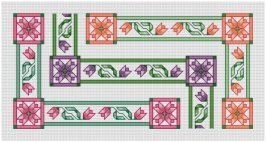How to Choose Scissors
for Cross Stitch
You can easily (and now, inexpensively) acquire scissors to use in your counted cross stitch projects. You need two styles, one to cut fabric and another to cut floss.
For both types, it is important to keep them sharp. To easily accomplish that, label them "fabric only." Ask everyone around you not to use them for paper or any other use.
As I was growing up, we avoided Mom's "seven deadly sins" of the household. Along with "getting into Mom's purse" and "putting leftovers into the refrigerator in a pan," "using Mom's fabric scissors" for anything but fabric was strictly verboten!
For good reason, though. Besides being sharp, they must be clean. You can transfer residue left from a prior cutting job onto your cross stitch project. If you don't know what the residue is, you will not know how best to clean it.
What to look for
One standard pair should measure about seven or eight inches long to use for cutting cross stitch fabric, such as aida cloth or linen. Since most cross stitch patterns are relatively small, you will cut fabric for many projects before equaling the amount of cutting required in a standard dress pattern. For that reason, inexpensive ones will work just fine and last for a long time.
If you have more than one pair at home, first see if they are sharp enough by cutting through two layers of fabric. If so, you can save yourself several dollars. Thoroughly clean both handles and blades with rubbing alcohol and cotton balls. (Be careful not to cut yourself when cleaning blades.)
For Cutting Floss

The second, smaller pair may be called "embroidery scissors" at your local store. Ideally, they should have a very pointed tip that curves upward. Held flat, these will perfectly cut threads close to the fabric without accidentally piercing it.
My favorites, pictured here, are Titanium, a light weight metal
stronger than steel. They resist corrosion and stay sharper longer.
I prefer the ones with a curved blade.
You may be able to substitute a pair from a manicure set, but be sure they are sharp enough to cut floss. If they have been used, you should thoroughly clean them as described above.
atherine Recommends "Buy an inexpensive pair seven or eight inches long at a local discount store and label them "fabric only." To help your family remember the new "fabric only rule," purchase a second pair for them, preferably in another color. Curved embroidery scissors, measuring about four inches long, may take a little longer to find in stores. Also, since they are so small, tie a bright loop of braided trim around the handle to make them easier keep track of at home."
A final note: Sharpening costs too much for unpredictable results, and often you have to leave them at the shop for a few days. Save yourself some aggravation! Buy inexpensive pairs and replace them when they dull. Demote the old ones to the family's "general use" pair. As for the curved ones, I have never had these successfully sharpened.
How they really work, and why left-handers should buy true left-handed scissors.If you have ever watched children first learning to use them, you have likely noticed that the material they try to cut -- whether it be paper, fabric, thread, or whatever -- bends down between the blades, folding rather than cutting. Thinking the scissors must be dull, you offer to lend a hand. You pick them up and cut the very same material with ease. Although sharpness can be a factor, the main reason this happens lies in the design. Mechanically, it's the shearing action made by bringing the two blades together that cuts the material, not the cutting of the blades themselves. As a right-handed person, when bringing the blades together, the natural action of my thumb pushes outward; at the same time, closing my fingers pushes the other blade inward. That very pressure, exerted as the top blade meets the bottom one, is what cuts. To demonstrate this, try using your left hand (if you are right handed) and try to cut something. While writing this, I tried to cut a paper towel with my sharp fabric scissors. Guess what? It folded. Back in my right hand, they cut through the towel like the proverbial hot knife through butter. As adults, we are not consciously aware of doing this. As children, we unconsciously learn it by trial and error. Mastering this is compounded for left-handers. Many scissors marked as "ambidextrous" are actually right-handed ones with no distinction between thumb and finger holes. Using these forces you to look over the top blade or hold your hand at an unnatural angle to see what you are cutting. If you are a left-handed adult, instead of using right-handed ones, look for a true left-handed pair with the blades in opposite orientation. The top blade should be on the left instead of the right, providing an unobstructed view when cutting. You will be glad you did. Look for a correctly oriented pair of scissors or find them on online at Amazon. |
Return to Selecting Counted Cross Stitch Supplies
Go to Better Cross Stitch Patterns Home Pattern

